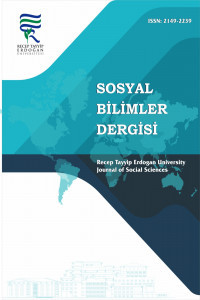Üniversite–Şehir İlişkisinde Yerleşkenin Yeri ve Etkisi: RTEÜ ve Rize Örneği
Üniversitelerin yeni misyonu olan topluma hizmet ve sanayi/teknolojide öncü rol üstlenme olgusunu hayata geçirmede, yerleşkelerin hangi özelliklere sahip olması gerektiği incelenmiştir. İyi bir eğitim yerleşkesi ve yine iyi bir araştırma yerleşkesi nasıl olmalıdır sorusuna cevap bulunmaya çalışılmıştır. Yine yerleşke-şehir ilişkisi bağlamında yerleşke tipleri incelenmiş; şehir içi yerleşke, şehir dışı yerleşke ve şehir üniversitesi seçenekleri ortaya çıkmıştır. Bunlar içinde hem yerleşkenin hem de şehrin imkânlarından yararlanmayı mümkün kılan şehir içi yerleşke modeli daha yararlı görülmüştür. RTEÜ yerleşkeleri olarak; Fener’deki Zihni Derin Yerleşkesi ve İslampaşa’daki Sağlık Yerleşkesi, bu tip yerleşke modeline uygun bulunmuştur. Rize’nin dar bir kıyı bandında kurulu olması nedeniyle, her iki yerleşkenin de şehrin imkânlarından yeterince yararlanamadıkları değerlendirilmiştir. Bu iki yerleşkenin şehrin imkânlarından daha iyi yararlanması ve şehre daha iyi katkıda bulunması için, buralarda ticaretin canlandırılması ve farklı temalara sahip alt merkezler oluşturulması önerilmiştir.
Anahtar Kelimeler:
Yerleşke, Şehir-Yerleşke İlişkisi, Üniversite ve Şehir İlişkisi, Eğitim Yerleşkesi, Araştırma Yerleşkesi
Location and Impact of the Campus in the University-City Relation: The Example of RTEÜ and Rize
The service to society and industry/technology is new mission of the universities. We examined the features considered to play a leading role in the realization of that phenomenon. We also tried to find an answer to the question of what a good educational campus and a good research campus should be. In the literature review, the relationship between the campus and the city was investigated; urban settlements, urban campus and city university options have emerged. Within these, the city campus model, which makes it possible to benefit from both the settlement and the city's facilities, has been seen as more useful. As RTEU campuses; The Zihni Derin Campus in the Fener and the Health Campus in İslampaşa were found suitable for this type of campus model. It is proposed to provide pedestrianization within the campus; removing some roads and transforming into green areas and to form runway, pedestrian path and bicycle path between the two campuses and the city center. In addition, a multi-centered city structure, a center of culture and art and multidisciplinary interaction centers were proposed.
Keywords:
Campus, City-Campus Relations, Town and Gown, Education Campus,
___
- Antalyalı, Ömer Lütfi, (2007), “Tarihsel Süreç İçerisinde Üniversite Misyonlarının Oluşumu” Süleyman Demirel Üniversitesi Sosyal Bilimler Enstitüsü Dergisi, Yıl: 2007/2, Sayı: 6, Isparta.
- American Academy (2015), Public Research Universities: Why They Matter, The Lincoln Project: Excellence and Access in Public Higher Education, American Academy of Arts & Sciences, 2015; https://www.amacad.org/LincolnProject; (10.11.2018)
- Büyükşahin Siramkaya, S.B. Çinar K., (2012), “Üniversite Kampüs Yerleşkelerinde Ortak Kullanım Mekânlarının İncelenmesi: Selçuk Üniversitesi Aleaddin Keykubat Kampüsü Örneği”, Selçuk Üniversitesi Mühendislik Mimarlık Fakültesi Dergisi, C.27, S.3.
- Calvo-Sotelo, P.C. (2010), The Concept of “Educational Campus” and its application in Spanish universities, CELE Exchange, 2010/8 ISSN 2072-7925; https://www.oecd-ilibrary.org/docserver/5kmbjxzp5ghc-en.pdf?expires=1538856759&id=id&accname= guest&checksum=5755436864289407E37834604DDB5CC8, (06.10.2018).
- Christiansee, Kees, (2007), “Campus and the City: Urban Design for Universities”, Campus and the City - Urban Design for the Knowledge Society, (Ed. K.Hoeger, K.Chritiaanse), Publ: gta Verlag, https://www.christiaanse.arch.ethz.ch/index.php?lang=de&page_id=108; (06.10.2018).
- Cisco, (2017), Creating the 21st Century Campus Innovation in higher education through collaborative solutions; White Paper; https://www.cisco.com/c/dam/en_us/solutions/industries/ downloads/creating-21st-century-campus-in-higher-education.pdf; (10.11.2018)
- Constantelos, D. (1999), “The Formation of the Hellenic Christian Mind,” Christian Hellenism: Essays and Studies in Continuity and Change, New Rochelle, New York and Athens ISBN: 0-89241-588-6; http://www.myriobiblos.gr/texts/english/Constantelos_1.html; (01.10.2018).
- Düzenli T. Akyol D. Mumcu S., (2017), “Üniversite Kampüsü Açık Mekânlarının Gençler Tarafından Kullanım Amaçlarının Belirlenmesi”, Uluslararası Sosyal Araştırmalar Dergisi, Cilt: 10 Sayı: 49, Nisan 2017.
- Erçevik, B. Önal, F., (2011), “Üniversite Kampüs Sistemlerinde Sosyal Mekan Kullanımları”, MEGARON 2011; C.6 S.3 s..151-161.
- Erkman, U., (1990). Büyüme ve Gelişme Açısından Üniversite Kampüslerinde Planlama ve Tasarım Sorunları, İTÜ Mimarlık Baskı Atölyesi, İstanbul.
- HHMI, (2003), Janelia Farm Research Campus Report on Program Development, Howard Hughes Medical Institute, November 2003.
- Hoeger, K., (2007), “Campus and The City – A Joint Venture”, Campus and the City - Urban Design for the Knowledge Society, (Ed. K.Hoeger, K.Chritiaanse), Publ: gta Verlag, https://www.christiaanse.arch.ethz.ch/index.php?lang=de&page_id=108; (06.10.2018).
- McMillen, D.P. (2001), Polycentric urban structure: The case of Milwaukee, Economic Perspectives, Federal Reserve Bank of Chicago, 2001; https://core.ac.uk/download/pdf/ 6793024.pdf (08.02.2019)
- Olay53, (2019), Recep Tayyip Erdoğan Üniversitesi’nde Teknokent Kurulması İçin İlk İmzalar Atıldı, Olay53.com Haber Sitesi, 15.01.2019; http://www.olay53.com/haber/recep-tayyip-erdogan-universitesinde-teknokent-kurulmasi-icin-ilk-imzalar-atild-676541.htm; (07.02.2019).
- Ranga M., and Etzkowitz H., (2012), Triple Helix Systems: An Analytical Framework for Innovation Policy and Practice in the Knowledge Society; https://triplehelix.stanford.edu/images/Triple_Helix_Systems.pdf; (10.11.2018).Rashdall, H. (1895), Universities of Europe in the Middle Ages, Oxford at the Clarendon Press; http://lollardsociety.org/pdfs/Rashdall_Universities_vol1.pdf; (01.10.2018).
- Rosser, John, H., (2001), Historical Dictionary of Byzantium, Scarecrow Press, 2001; https://b-ok.cc/book/698028/347a51; (08.02.2019).
- Rukancı, F. ve Anameriç, H., (2016), Ortaçağda İlk Üniversiteler: Studium Generale, Felsefe Dünyası, 2004/1, Sayı 39, ss.170-186.
- Saklı, A.R., Akbulut Akdoğar, H.T., (2017), “Dünyada ve Türkiye’de Üniversitelerin Tarihi Gelişimi” Recep Tayyip Erdoğan Üniversitesi Öğrenci ve Akademisyenleri ile Rize Halkının Karşılıklı Algı ve Beklentileri, (Ed. Ali Rıza Saklı), RTEÜ Yayını, Rize.
- Sorbonne, (2018), Sorbonne University History; https://www.sorbonne-universite.fr/en/university/history-and-heritage/history; (01.10.2018)
- Sunar, C. (1967), İslâm Felsefesi Dersleri, Ankara Üniversitesi, İlahiyat Fakültesi Yayınları No. LXXX, Ankara.
- Trullén J, Boix R, (2003) Barcelona, Policentric Metropolis and Network of Cities, Workshop on Spatial Networks and Clusters: Urban and Regional Prosperity in a Globalised Economy, Universitat Rovira i Virgili, March 6-8 (2003).
- Türeyen, M. N., (2002), Yükseköğretim Kurumları Kampuslar, Tasarım Yayın Grubu.
- Viale, R., and Ghiclione, B., (1998), The Triple Helix Model: a tool for the study of european regional socio-economic systems, The IPTS Report 29, 1-8; https://studylib.net/doc/7795751/the-triple-helix-model--a-tool-for-the-study-of-european-...; (10.11.2018).
- Wikipedia, (2018a), University Of Paris, Wikipedia; https://en.wikipedia.org/wiki/University_of_Paris; (06.10.2018).
- Wikipedia, (2018b), University of Constantinople, Wikipedia; https://en.wikipedia.org/wiki/University_of_Constantinople; (06.02.2019)
- Wissema, J.G.,(2009), Üçüncü Kuşak Üniversitelere Doğru; Geçiş Döneminde Üniversiteleri Yönetmek, Özyeğin Üniversitesi Yayını, 2.b., İstanbul.Yılmaz, S. (2015) “Bir Kampüs Açık Mekânın Çevresel Tasarımı: Süleyman Demirel Üniversitesi Orman Fakültesi Binası”, Kastamonu Üniversitesi Orman Fakültesi Dergisi, 2015, 15 (2) s.297-307.
- ISSN: 2149-2239
- Yayın Aralığı: Yılda 2 Sayı
- Başlangıç: 2015
- Yayıncı: Recep Tayyip Erdoğan Üniversitesi
